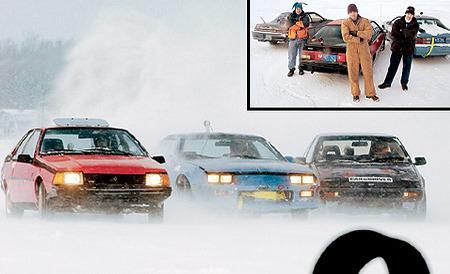Rear Drive
There are exceptions, but a $1000 rear-drive car is almost guaranteed to be some sort of Detroit sled. And since we live near the Motor City, there were plenty of choices. I had my eye on a 1976 Caddy. But it used a carburetor, and I wanted to maximize the chance that my car would start in 10-degree weather and minimize the chance I’d be under the hood fiddling with a stuck choke. Sorry, old-schoolers, but in my opinion, any older, carbureted car was bound to screw me just when I least wanted to remove a glove.
I wanted a fuel-injected car, and that significantly narrowed my choices because the domestics were slow to adopt injection. Locally, $1000 fuel-injected cars were in short supply. After a few weeks, I got desperate and widened my search via the Internet, relying heavily on eBay, where I found a perfect candidate—a 1989 Chevy Camaro RS—in Virginia. I wasn’t too comfortable buying a car without first inspecting it, but hey, it wasn’t my money, so I put in a $760 bid and won the car.
Three days later, road warrior Michael Lapprich arrived at our office with the Camaro in tow. I did not get a good deal. The sagging doors didn’t open, they sort of fell off their latches. The old Chevy had no headliner, rear-hatch struts, or rear-hatch lock. Wires dangled from the bare-metal ceiling, and the door panels had speaker holes but no speakers. The seats were covered with a crime-scene stain pattern, and the exterior had perhaps the worst paint job I’ve ever seen: Each panel was a different shade, and the finish texture resembled a dry lake bed.
On the highway, the Camaro bobbed and heaved so hideously it felt as though these very shocks had been present for every one of the 179,000 miles showing on the odo. But it fired up instantly every time, thanks to the 5.0-liter V-8’s throttle-body fuel-injection system. Just as important were the 170 horses. Not much, but in the crowd it’d be running in, I figured that would be plenty, and unlike Robinson, who simply hoped to nauseate the rest of us, I wanted to win at least some portions of the test.
Then about three weeks after Robinson and I got our cars, I heard Markus on the phone negotiating for what sounded like a killer ride. It was a Subaru XT6 that was listed for $1500. I never thought the guy would come down to a grand, and then I heard Markus say, “Well, it’s for a Car and Driver story, and all we have is a thousand bucks.” Pause. “You will? Okay, great. I’ll be right over.”
Was it me, or had Markus traded Car and Driver fame for a cheaper price? There wasn’t a rule about that, but it seemed unfair, especially after Robinson and I had bought our cars without throwing the C/D name around. I didn’t get really pissed until I drove the XT6 a few days later. It was a ringer—quick, tight, and solid. My Camaro was a dead duck.
If Markus hadn’t returned to the office bragging about the car he bagged, I probably wouldn’t have done anything. But of course he blabbed. And blabbed. For a week, you could hear him harpooning unsuspecting staff members and boasting about the great deal he’d made and how wonderful his car was. Great deal, my ass—he cheated! The way I saw it, I, too, could—and should—dip into the C/D name-dropping kitty.
I made one call to Holley Performance and sweet-talked the media and PR coordinator, Matt Held, into sending me a nitrous-oxide system that usually sells for about $550. My cost: $0. Cha-ching! Value parity.
Nitrous is a discreet way to cram extra oxygen into the engine to boost horsepower at the press of a button. My kit added as much as 150 horsepower, depending on which of the supplied nozzles was plumbed into the intake. I didn’t want my Camaro raising any undo suspicions, so I chose the kit pieces that would add only 100 ponies. Yes, I thought my little cheater system was justified, but there was no need to show my hand. I installed the N2O bottle where the jack normally goes and covered all the lines and hardware with stock GM wiring sheaths. I hid the switch underneath the passenger seat and pulled it out at test time.
Everything worked perfectly. On nitrous, the Camaro was damn quick, hitting 60 mph in 7.1 seconds—more than a second quicker than the Chevy was in 1989 and 2.4 seconds quicker than the XT6. It handily won every acceleration test. Since a car that can accelerate to 60 in less than eight seconds is no big thing these days, neither Markus nor Robinson had any suspicions.


Leave a Reply